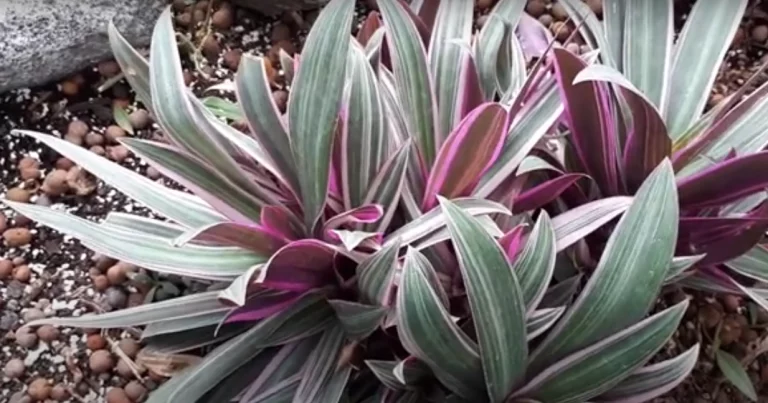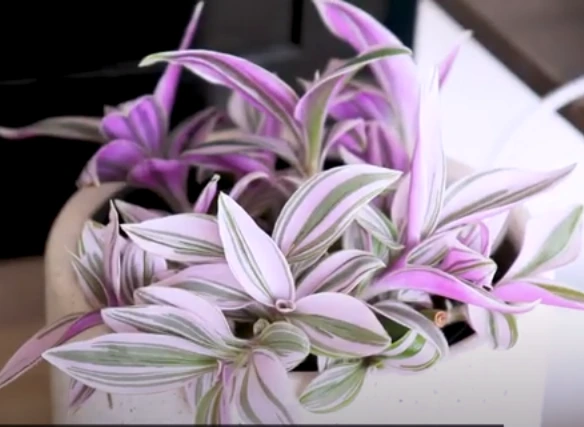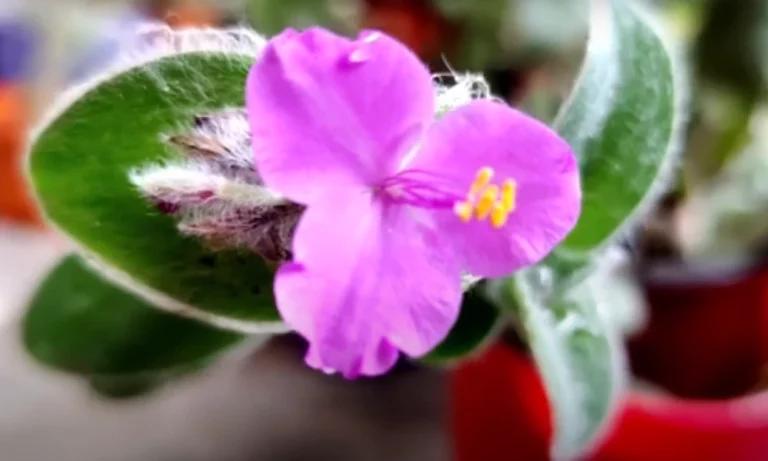Tradescantia occidentalis: Ultimate Growing Guide
As an experienced horticulturalist, I’m always on the lookout for low-maintenance perennials that provide a pop of color to garden beds or containers. One of my favorites is Tradescantia occidentalis, commonly known as the prairie or western spiderwort.
This hardy native wildflower offers electric blue-purple blooms on slender arching stems above long, elegant grass-like foliage. It does well in full sun or partial shade and isn’t too picky about soil conditions as long as there’s decent drainage. Tradescantia occidentalis is drought and pest resistant, attracts pollinators, and can handle the occasional prune or shear to keep it tidy.
Some key things to know about the western spiderwort:
- Hardiness – Perennial in zones 4-9, can withstand cold winters and hot summers
- Native range – Found natively across the Great Plains region from Minnesota to Texas
- Mature size – Grows 1-2 feet tall and spreads 1-3 feet wide
- Flowers – Showy clusters of vibrant blue to purple 3-petaled blooms with contrasting yellow stamens that each last only one day
- Foliage – Slender grassy leaves grow up to 15 inches long
- Soil – Tolerant of average to poor soil, must have good drainage
- Sun – Full sun to partial shade
- Uses – Gardens, borders, containers, meadow/prairie plantings
Some people say Tradescantia occidentalis can spread aggressively under certain conditions and may need to be kept in check. But I actually enjoy that it freely self-seeds – it creates more western spiderworts to brighten up my gardens!
Its common name comes from the fact that dewdrops on the arched foliage strands make it look like a spider web. It was named after John Tradescant, a gardener and botanist who traveled the world collecting specimens that formed an early botanical garden in England in the 1600s.
So in summary, if you’re looking for a low maintenance upright clumping perennial that brings unique texture along with vivid pops of color to your outdoor space, Tradescantia occidentalis just might be the perfect choice!
Now let’s get into all the details on how to successfully grow this western native wildflower…
How to Grow Tradescantia occidentalis
Growing the western spiderwort is super easy – it’s a tough reliable perennial that will thrive with basic care. Here’s what you need to know to successfully cultivate Tradescantia occidentalis in your yard, garden or containers.
Soil requirements: This wildflower adapts to most soil types, as long as there is decent drainage. It grows best in medium moisture, well-draining soil. Avoid planting it in heavy clay that doesn’t drain well. Before planting, I like to amend the soil with a few inches of compost or other organic material to enrich it.
- Ideal pH range: 5.5 to 7.5 (slightly acidic to neutral)
- Loose, average soils with organic material added
- Well-drained but maintains even moisture
- Loamy, sandy, rocky soils are all fine
You definitely don’t need perfect soil or meticulous nutrient levels to grow Tradescantia occidentalis well. Just give it decent drainage and moderate fertility and it will thrive with minimal fuss.
Sunlight needs: The prairie spiderwort does well in full sun to partial sunlight. I would give it at least 4-6 hours of direct sun for the best growth and flowering. It can tolerate light shade but may get leggy and won’t bloom as heavily.
Watering: Water moderately or just rely on rainfall once established. The soil should not be allowed to dry out completely but also shouldn’t be constantly soggy wet. Here are some tips:
- Water 1-2 times per week on average, adjusting for weather
- Cut back on watering once root system is developed
- Allow soil to moderately dry out between waterings
- Avoid overwatering or constantly soggy soils
Temperature & zones: Cold hardy to zone 4, this plant can withstand frigid winters. It thrives in summer heat and humidity across a wide region. Zones 4-9 are all fine for Tradescantia occidentalis.
Fertilizer: Fertilize lightly with a balanced organic fertilizer once or twice during the main growing season, in early spring and midsummer. Avoid heavy feeding, as this plant doesn’t need much extra nutrients.
Propagation: You can propagate from seed or propagate Tradescantia occidentalis by dividing existing plants. I like dividing because it’s fast and easy!
- Divide in early spring or fall
- Lift entire plant and divide root ball into pieces
- Replant 12-18 inches apart
- Water well until re-established
Western spiderwort grown from seed can take 2-3 years to reach maturity and bloom. Propagating by division will allow you to multiply plants quickly.
Hopefully these growing tips give you confidence that adding Tradescantia occidentalis to your gardens will be simple and rewarding! Let your soil prep and maintenance be minimal, and this unfussy prairie native will reward you with vibrant flowers and graceful greenery.
Next I’ll go into more detail on caring for mature plants and keeping them looking their best season after season…
Tradescantia occidentalis Care
Caring for western spiderwort is so easy! These unfussy natives are highly resilient plants once established. Just a little basic maintenance will keep your Tradescantia occidentalis looking fresh.
Pruning: Do prune or shear back plants periodically to control spread, improve appearance, and encourage new growth & flowering. You can:
- Prune off spent flower stems down to the foliage
- Cut back leggy or damaged stems at any time
- Shear or thin congested clumps by 1/3 to 1/2
- Deadhead regularly to promote new blooms
- Chop plants back hard in late fall if desired
Don’t be shy about giving Tradescantia occidentalis a haircut! The foliage may look ratty by summer’s end or after exposure to cold, so I cut all stems back to 6-12 inches above the ground. This pruning rejuvenates plants for abundant new growth and flowers the following season.
Pest/Diseases: Thankfully western spiderwort has excellent native pest and disease resistance. You rarely need to intervene. Issues to watch for include:
- Aphids – Treat with insecticidal soap spray
- Snails/slugs – Remove by hand or use iron phosphate bait
- Legionnaire’s disease – Avoid overhead watering and improve air circulation
If leaves exhibit fungal spots, remove and destroy affected foliage. Make sure plants have sufficient spacing and air flow.
Troubleshooting problems: It’s unusual to have issues with Tradescantia occidentalis, but here are some tips if you notice:
- Poor flowering – Often just needs more sun. Truncate old stems to stimulate new blooms.
- Invasive spread – Control by pruning fuller clumps back by half in midsummer.
- Rotting stems/foliage – Improve drainage; cut away dead material.
This vigorous spiderwort tolerates drought, short-term floods, heat waves, bitter cold snaps, poor soil, and general neglect once established. As long as you don’t overwater or crowd it, problems should be rare!
Beyond structural pruning, occasional deadheading as flowers fade, and keeping it free of nearby weeds, I don’t spend much time actively caring for Tradescantia occidentalis. Give it full sun, average soil drainage, moderate moisture, and let the handsome architectural form and electric flowers shine!
Here are a few more western spiderwort growing and care tips:
- Mulch plants in very cold climates to protect roots
- Stake tall floppy stems that can’t support flower weight
- Divide congested clumps every 3-5 years in early spring
- Mix organic compost into soil annually to feed plants
- Leave dried flower stalks/seed heads for winter interest
- Keep nearby plants from crowding out Tradescantia occidentalis
This carefree beauty is native from Saskatchewan down to Texas for good reason – it thrives across a wide region with minimal help! Adaptable and undemanding, western spiderwort fits easily into gardens and meadows as a vivid accent.
If you love the idea of unfuss perennials but don’t want boring, overused plants, give Tradescantia occidentalis a try. The electric blue flowers and structural foliage look fantastic with little work on your part.
Let me know if you have any other tips and tricks for maintaining your western spiderwort stands season after season! It’s one of those set-it-and-forget-it perennials, but I’m always open to learning more.
Tips for Growing Tradescantia occidentalis in Garden and Containers
Over the years I’ve accumulated plenty of wisdom on how best to grow Tradescantia occidentalis in gardens and containers for maximum enjoyment! Here are my top tips:
Container gardens – The western spiderwort makes a fantastic container plant on patios, porches and entryways. Its vertical structure is perfect for mixed planters or solo pots. For containers:
- Choose a pot at least 12-18 inches wide
- Make sure container has drainage holes
- Use a quality potting mix
- Add organic material like compost for nutrients
- Situate in full sun to part sun
- Water when soil surface is partly dry 1-2″ down
The spidery foliage drapes nicely over container edges. Tradescantia occidentalis combines beautifully with grasses, salad flowers like calendula & nasturtiums, trailing plants, compact annuals, and more upright perennials like salvia and coneflowers.
Companion plantings – This adaptable prairie native grows happily alongside many other flowers, grasses, vegetables and herbs. Some great companion plants are:
- Grasses like fescues, grama, and switch grass
- Native wildflowers like black-eyed susan, bee balm, asters
- Drought-tolerant perennials like Russian sage, blanketflower
- Pollinator attractors like cosmos, zinnias, marigolds
- Vegetables like beans, tomatoes, Swiss chard
Groupings of 3-7 Tradescantia occidentalis plants make a great accent in beds and borders. Allow them to intermingle with other medium-height perennials and annuals that won’t overwhelm them.
Landscaping uses – Here are some ways I like to utilize the prairie spiderwort’s charming flowers and structural foliage in my outdoor spaces:
- Mass along borders and garden edges
- Naturalize and fill in around trees & shrubs
- Underplant roses, peonies, hydrangeas
- Scatter through cottage gardens
- Include in native meadow & prairie plantings
- Grow in rock gardens and xeriscapes
- Set off walkways and entry paths
I also find Tradescantia occidentalis to be perfect for backyard cutting gardens! The elegant flower stems with electric color last nicely in bouquets. And this tough plant blooms abundantly for months on end.
Some final tips:
- Buy plants from local native plant nurseries when possible
- Give new plantings a bit of shade the first week or two
- Leave some spent blooms for self-sowing more spiderworts
- Enjoy how they combine with grasses for beautiful texture
- Appreciate their glow when backlit by the evening sun!
What are your favorite ways to showcase Tradescantia occidentalis in the landscape? I hope these ideas and tips inspire you to find a spot (or two or three) for this long-flowering hardy native wildflower. It has so much to offer gardens and gardeners!
Frequently Asked Questions
Here are answers to some of the most common FAQs about Tradescantia Occidentalis:
Is the western spiderwort deer resistant?
Yes! Tradescantia occidentalis is mostly left alone by deer thanks to its tough slender foliage. It’s a great landscape choice if you struggle with deer grazing down plants in your area.
What kind of soil does it need?
This adaptable wildflower grows in all kinds of soil – sand, clay, rocky ground, and more. Just make sure the drainage is decent. Adding compost when you plant can be beneficial but isn’t mandatory.
Can it tolerate drought?
Prairie spiderwort is quite drought tolerant when established. It uses moisture efficiently, so don’t be afraid to cut back on watering it. The slender leaves lose less moisture than broad-leaved plants.
Does Tradescantia occidentalis spread aggressively?
It can spread freely by self-seeding under ideal conditions, but I haven’t found it to be aggressively invasive. Just keep an eye on the seedlings so they don’t overwhelm nearby plants. Its spreading habit makes it great for naturalizing.
What are the medicinal uses?
Traditionally, the sap from broken spiderwort stems was used to treat insect bites and stings, minor cuts, and skin irritation. The fuzz on the leaves and stems may help relieve itchiness. Caution is advised before ingesting.
Is it toxic or poisonous?
Tradescantia occidentalis does not appear to be toxic or poisonous to people or pets, but care should always be exercised around unknown plants. It has a history of medicinal skin applications. The blue pigment in the flower stamens is used to assess radiation levels.
How much sunlight does western spiderwort need?
For the best flowering and strong growth, provide this perennial with 4-6 hours of direct sun daily. It also tolerates light afternoon shade. More sunlight encourages more prolific blooms.
Have more questions? Ask me below! I love helping spread knowledge and excitement about growing Tradescantia occidentalis.
Conclusion
For gardens and gardeners seeking sturdy, vibrant perennials that largely take care of themselves, you can’t go wrong with Tradescantia occidentalis! This tough prairie native offers electric color on slender arching stems, graceful narrow foliage, and months of flowers with very little work on your end.
As you can see, the western spiderwort is adaptable, unfussy, deer resistant, drought tolerant and super easy to grow. From soil conditions to sunlight to propagation and care, it couldn’t be much lower maintenance. Give Tradescantia occidentalis the basic habitat it asks for, then sit back and revel in those eye-catching blue-purple blooms all season long!




